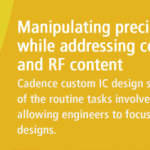About 4 years ago some of my semiconductor cohorts urged me to blog. “Hey Dan, you’re a funny guy, write about EDA and IP, make us laugh!” Of course what I think is funny most people think is snarky, which is a nice word for being a smart ass. The traditional semiconductor press was crumbling, the non traditional EDA websites were outdated,… Read More
 A Webinar About Electrical Verification – The Invisible Bottleneck in IC DesignElectrical rule checking (ERC) is a standard part…Read More
A Webinar About Electrical Verification – The Invisible Bottleneck in IC DesignElectrical rule checking (ERC) is a standard part…Read More Signal Integrity Verification Using SPICE and IBIS-AMIHigh-speed signals enable electronic systems by using memory…Read More
Signal Integrity Verification Using SPICE and IBIS-AMIHigh-speed signals enable electronic systems by using memory…Read More imec on the Benefits of ASICs and How to Seize ThemIn an era where product differentiation increasingly depends…Read More
imec on the Benefits of ASICs and How to Seize ThemIn an era where product differentiation increasingly depends…Read More MZ Technologies Launches Advanced Packaging Design Video SeriesIn a significant move aimed at empowering semiconductor…Read More
MZ Technologies Launches Advanced Packaging Design Video SeriesIn a significant move aimed at empowering semiconductor…Read MoreNVM IP: why only anti fuse solution from Novocell Semiconductor is 100% reliable?
The concept of Non Volatile Memory (NVM) block which could be integrated into an ASIC is relatively recent, Novocell for example has been created in 2001. NVM IP integration into an ASIC is a pretty smart technology: integrating from a few bytes to up to Mbits into a SoC can help reducing the number of chips in a system, increase security… Read More
Addressing the Nanometer Digital Design Challenges! (Webinars)
Optimizing logical, physical, electrical, and manufacturing effects, Cadence digital implementation technology eliminates iteration without sacrificing design quality by addressing timing sensitivity, yield variation, and leakage power from the start. … Read More
Synopsys Protocol Analyzer Video
Josefina Hobbs, a solutions architect at Synopsys, demonstrates protocol debug made easy using the Synopsys Protocol Analyzer. This gives users a graphical view of the transfers, transaction, packets and handshaking of a protocol. The video also shows the integration of Synopsys Protocol Analyzer with SpringSoft’s… Read More
Parasitic-Aware Design Flow with Virtuoso
I learn a lot these days through webinars and videos because IC design tools like schematic capture and custom layout are visually oriented. Today I watched a video presentation from Steve Lewis and Stacy Whiteman of Cadence that showed how Virtuoso 6.1.5 is used in a custom IC design flow:… Read More
Addressing the Nanometer Custom IC Design Challenges! (Webinars)
Selectively automating non-critical aspects of custom IC design allows engineers to focus on precision-crafting their designs. Cadence circuit design solutions enable fast and accurate entry of design concepts, which includes managing design intent in a way that flows naturally in the schematic. Using this advanced, parasitic-aware… Read More
Jasper Customer Videos
Increasingly at DAC and other shows, EDA companies such as Jasper are having their customers present their experiences with the products. Everyone has seen marketing people present wonderful visions of the future that turn out not to materialize. But a customer speaking about their own experiences has a credibility that an EDA… Read More
ARM and TSMC Beat Revenue Expectations Signaling Strength in a Weakening Economy?
Fabless semiconductor ecosystem bellwethers, TSMC and ARM, buck the trend reporting solid second quarters. Following “TSMC Reports Second Highest Quarterly Profit“, the British ARM Holdings “Outperforms Industry to Beat Forecasts“. Clearly the tabloid press death of the fabless ecosystem claims… Read More
MemCon Returns
Back before Denali was acquired by Cadence they used to run an annual conference called MemCon. Since Denali was the Switzerland of EDA, friend of everyone and enemy of none, there would be presentations from other memory IP companies and from major EDA companies. For example, in 2010, Bruggeman, then CMO of Cadence, gave the opening… Read More
The Future of Lithography and the End of Moore’s Law!
Thisblog with a chart showing that the cost of given functionality on a chip is no longer going to fall is, I think, one of the most-read I’ve ever written on Semiwiki. It is actually derived from data nVidia presented about TSMC, so at some level perhaps it is two alpha males circling each other preparing for a fight. Or, in this… Read More












Quantum Computing Technologies and Challenges